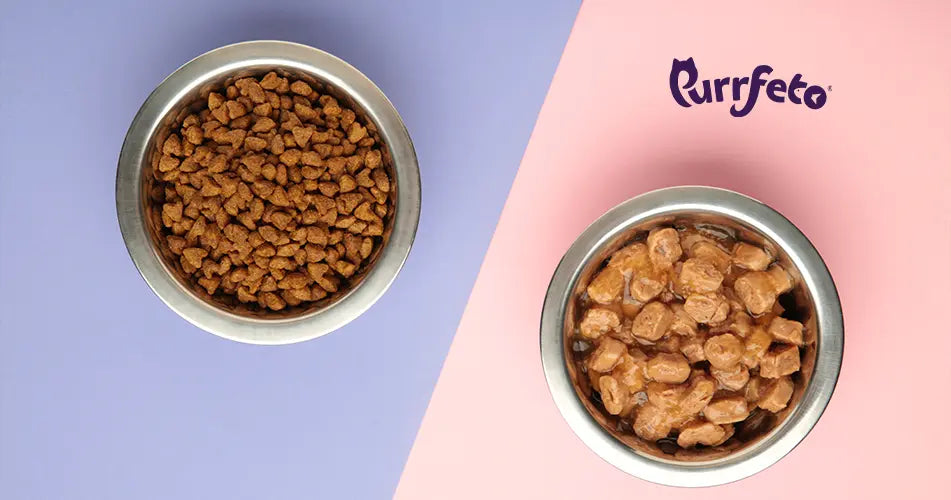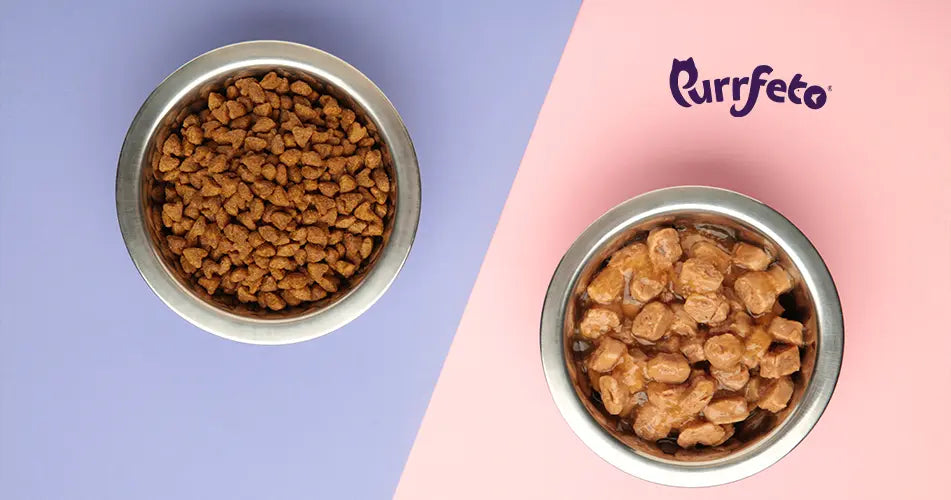Feeding your cat means much more than filling a bowl: It is about making the smart food choice which positively supports your feline friend.
One question many cat parents have is when it comes to feeding their cats is: wet vs dry cat food – which is better? Choosing between wet or dry cat food totally relies on what suits your cat the best. Most vets recommend the ideal best cat food based on the cat’s age, weight and health.
In this blog, we will understand the difference between wet cat food & dry cat food, the advantages of wet cat food and dry cat food, and whether the best method to address feeding your cat is using both methods.
Differences Between Wet Cat Food and Dry Cat Food
The biggest difference is moisture levels. Wet cat food contains about 70-80% water in it, whereas dry cat food has 10% water. Purrfeto cat food goes a step further, with a high moisture content of around 87%, making it an excellent choice for cats who don't drink enough water on their own.
Being hydrated contributes to kidney health and decreases the risk of urinary tract infections and bladder stones which are problems not often found in kittens but very common in adult and senior cats.
Purrfeto Ocean Platter in Jelly for kittens contains approximately 89.5% moisture content in it, which helps in lowering the risk of UTIs by up to 40%. This helps in keeping your little one healthy and happy.
Fats, Vitamins, and Nutritional Value
Whether they are labelled as nutritionally complete, both dry and wet cat food can supply a healthy source of nutrition to your cat. However, some information about how they will preserve their nutrients (when using good quality ingredients) will vary.
Wet food generally offers:
- Higher animal protein content: Wet food is ideal to be fed to obligate carnivores like cats.
- Lower carbohydrates: Low amount of carbohydrates helps in weight management.
- Better palatability: Because of texture and aroma.
Dry food typically provides:
- More calories per gram: Useful for active or underweight cats.
- Crunchy texture: Can help reduce plaque build-up on teeth.
- Longer shelf life: Convenient and cost-effective.
Benefit from more water intake includes better kidney functions, better metabolism along with regulating body temperature. Among older and adult cat's kidney issues is a common issue. Not drinking enough water throughout the day can put strain on their kidneys. This increases the chances of getting chronic kidney disease which is usually seen in older cats.
That’s where Purrfeto comes in. Our wet cat food range contains a high moisture content of 87% for adult cats and 89% for kittens, helping to keep your furry companions well-hydrated every day.
Should I Feed My Cat Dry or Wet Cat Food? Or both?
You can decide whether to feed your cat wet or dry food based on their nutrition, convenience, and health needs. Let’s break it down based on the benefits of each type.
Dry Cat Food Benefits
- Convenience: Dry cat food is easy to measure, store. Also, it doesn't spoil after opening the packaging.
- Cost-effective: Dry cat food is generally more affordable per meal compared to wet food, making it a practical option for everyday feeding.
- Dental benefits: Dry cat food has a crunchy texture. This helps in having clean teeth and reduces tartar buildup.
- Free feeding: You can leave it out for longer periods, which is ideal for busy households.
Wet Cat Food Benefits
- Hydration: Important for cats with kidney or urinary problems, especially if these cats don't drink enough water.
- Taste: Cats generally like the smell and texture of wet food.
- Easier to chew: Wet cat food is important for senior cats or in cats with dental disease.
- Lower calorie density: This can help manage your cat's weight because your cat feels satisfied from the moisture.
So, Which Is Better?
The answer would be solely dependent on the health and lifestyle preferences of your cat. Some cats prefer only dry or only wet foods, but veterinarians recommend mixing them while feeding your cats. Mixing both the cat food types helps in providing proper nutrition and hydration to the cat.
Why Mixing Wet and Dry Food Works
When wet and dry cat food is mixed, it gives your cat access to food in both forms. It accommodates your chosen nutrition (wet or dry), taste, and convenience while still enabling some specific health impetus.
Cat Health Needs
Each cat is different, and their diet should reflect that. Here’s how a mixed diet can address specific needs:
- Weight control: Mixing wet food into dry meals helps reduce calorie intake while keeping your cat satisfied.
- Hydration: Adding wet food to your cat’s helps in ensuring that your cat gets enough fluids. This also helps in reducing the risk of having UTI's. Purrfeto Ocean Fish in Gravy for Adults, with 87% moisture, is a delicious and hydrating option to keep your cat healthy and happy.
- Digestive health: The high moisture content in wet food can prevent constipation and promote smoother digestion.
- Kidney health: Particularly in older cats, proper hydration from wet food supports better kidney function.
In case your cat has health conditions such as diabetes or kidney disease your veterinarian would prescribe a diet.
Cat Food Preferences
Cats are notorious for being picky eaters. Some cats prefer crunchy kibble, while others may only eat soft, moist food. By offering both, you:
- Cater to your cat’s texture preferences.
- Increase the chances of them eating enough each day.
- Prevent boredom by adding variety to their meals.
You can mix both the types of cat food together and serve your cat during different times of the day. This would totally depend on your cat’s routine.
Tips That You Can Follow While Switching or Combining Cat Foods
- Transition diet slowly: Sudden changes in food can cause digestive upset in adult cats. Begin by mixing a small portion of the new food with their current diet, and slowly increase the amount over the course of 7 to 10 days. This helps your cat adjust smoothly without digestive issues.
- Mind your portion sizes: If you are mixing both cat foods, be careful that you are not overfeeding your cat. Use portion sizes that you see on the packaging or consult with your veterinarian if you are unsure.
- Consistency: Make sure your cat is being fed daily and make sure you weigh your cat on a regular basis.
- Saucers/bowls need to be cleaned often: Wet food can spoil fairly quickly if left out. Make sure you take the food away if uneaten after a matter of 30 to 60 minutes.
Conclusion
When it comes to wet vs dry cat food, it ultimately comes down to what your cat needs and wants. Dry food is easier to store and to feed. Wet food is better for hydration and also offers appeal to many cats.
Always consult a veterinarian when making your cat's diet changes, even when selecting the best cat food! The best food is what makes your cat happy and healthy - it doesn't matter if it is wet or dry!



 Back to Blogs
Back to Blogs 





